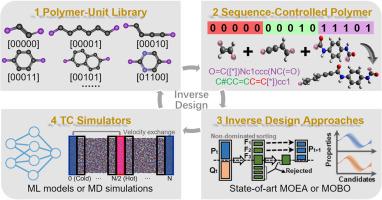当前位置:
X-MOL 学术
›
Mater. Today Phys.
›
论文详情
Our official English website, www.x-mol.net, welcomes your feedback! (Note: you will need to create a separate account there.)
AI-assisted inverse design of sequence-ordered high intrinsic thermal conductivity polymers
Materials Today Physics ( IF 11.5 ) Pub Date : 2024-04-16 , DOI: 10.1016/j.mtphys.2024.101438 Xiang Huang , C.Y. Zhao , Hong Wang , Shenghong Ju
Materials Today Physics ( IF 11.5 ) Pub Date : 2024-04-16 , DOI: 10.1016/j.mtphys.2024.101438 Xiang Huang , C.Y. Zhao , Hong Wang , Shenghong Ju

|
Artificial intelligence (AI) promotes the polymer design paradigm from a traditional trial-and-error approach to a data-driven style. Achieving high thermal conductivity (TC) for intrinsic polymers is urgent because of their importance in the thermal management of many industrial applications such as microelectronic devices and integrated circuits. In this work, we have proposed a robust AI-assisted workflow for the inverse design of high TC polymers. By using 1144 polymers with known computational TCs, we construct a surrogate deep neural network model for TC prediction and extract a polymer-unit library with 32 sequences. Two state-of-the-art multi-objective optimization algorithms of unified non-dominated sorting genetic algorithm III (U-NSGA-III) and q-noisy expected hypervolume improvement (qNEHVI) are employed for sequence-ordered polymer design with both high TC and synthetic possibility. For triblock polymer design, the result indicates that qNHEVI is capable of exploring a diversity of optimal polymers at the Pareto front, but the uncertainty in Quasi-Monte Carlo sampling makes the trials costly. The performance of U-NSGA-III is affected by the initial random structures and usually falls into a locally optimal solution, but it takes fewer attempts with lower costs. 20 parallel U-NSGA-III runs are conducted to design the pentablock polymers with high TC, and half of the candidates among 1921 generated polymers achieve the targets (TC > 0.4 W mK and SA < 3.0). Ultimately, we check the TC of 50 promising polymers through molecular dynamics simulations and reveal the intrinsic connections between microstructures and TCs. Our developed AI-assisted inverse design approach for polymers is flexible and universal, and can be extended to the design of polymers with other target properties.
中文翻译:

人工智能辅助序列有序高本征导热聚合物的逆向设计
人工智能(AI)将聚合物设计范式从传统的试错方法提升为数据驱动的风格。由于本征聚合物在微电子器件和集成电路等许多工业应用的热管理中的重要性,实现本征聚合物的高导热率 (TC) 迫在眉睫。在这项工作中,我们提出了一种强大的人工智能辅助工作流程,用于高TC聚合物的逆向设计。通过使用具有已知计算 TC 的 1144 种聚合物,我们构建了用于 TC 预测的替代深度神经网络模型,并提取了具有 32 个序列的聚合物单元库。两种最先进的多目标优化算法:统一非支配排序遗传算法 III (U-NSGA-III) 和 q-噪声预期超体积改进 (qNEHVI) 用于序列有序聚合物设计,同时具有高TC 和合成的可能性。对于三嵌段聚合物设计,结果表明 qNHEVI 能够在 Pareto 前沿探索多种最佳聚合物,但准蒙特卡罗抽样的不确定性使得试验成本高昂。 U-NSGA-III的性能受初始随机结构的影响,通常会陷入局部最优解,但尝试次数较少,成本较低。进行了 20 次并行 U-NSGA-III 运行来设计具有高 TC 的五嵌段聚合物,1921 种生成的聚合物中的一半候选聚合物达到了目标(TC > 0.4 W mK 和 SA < 3.0)。最终,我们通过分子动力学模拟检查了 50 种有前途的聚合物的 TC,并揭示了微观结构和 TC 之间的内在联系。我们开发的人工智能辅助聚合物逆向设计方法灵活且通用,可以扩展到具有其他目标性能的聚合物的设计。
更新日期:2024-04-16
中文翻译:

人工智能辅助序列有序高本征导热聚合物的逆向设计
人工智能(AI)将聚合物设计范式从传统的试错方法提升为数据驱动的风格。由于本征聚合物在微电子器件和集成电路等许多工业应用的热管理中的重要性,实现本征聚合物的高导热率 (TC) 迫在眉睫。在这项工作中,我们提出了一种强大的人工智能辅助工作流程,用于高TC聚合物的逆向设计。通过使用具有已知计算 TC 的 1144 种聚合物,我们构建了用于 TC 预测的替代深度神经网络模型,并提取了具有 32 个序列的聚合物单元库。两种最先进的多目标优化算法:统一非支配排序遗传算法 III (U-NSGA-III) 和 q-噪声预期超体积改进 (qNEHVI) 用于序列有序聚合物设计,同时具有高TC 和合成的可能性。对于三嵌段聚合物设计,结果表明 qNHEVI 能够在 Pareto 前沿探索多种最佳聚合物,但准蒙特卡罗抽样的不确定性使得试验成本高昂。 U-NSGA-III的性能受初始随机结构的影响,通常会陷入局部最优解,但尝试次数较少,成本较低。进行了 20 次并行 U-NSGA-III 运行来设计具有高 TC 的五嵌段聚合物,1921 种生成的聚合物中的一半候选聚合物达到了目标(TC > 0.4 W mK 和 SA < 3.0)。最终,我们通过分子动力学模拟检查了 50 种有前途的聚合物的 TC,并揭示了微观结构和 TC 之间的内在联系。我们开发的人工智能辅助聚合物逆向设计方法灵活且通用,可以扩展到具有其他目标性能的聚合物的设计。



























 京公网安备 11010802027423号
京公网安备 11010802027423号